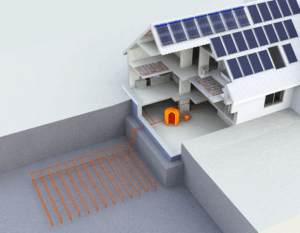There has always been a fair amount of fluctuation in the price of natural gas used to heat homes and businesses. Up until the last year or so, that fluctuation stayed in a fairly small range, keeping gas heating relatively economical when compared to other heating solutions such as an all-electric furnace. But the landscape for heating homes and businesses is changing. Due to factors such as increased demand, supply issues, and just bad weather across North America and Europe, gas prices have been going through the roof.
In Alberta alone, the October 2021 average cost of natural gas was 101% higher than the previous October. The month-to-month increase is as much as 30%, and there is no indication this trend will cease anytime soon. This news is certainly not good and can be devastating for homeowners and businesses trying to stabilize their operational costs. It has many looking for alternatives that include geothermal heating systems.
Why geothermal makes sense
A geothermal system to heat and cool a home or business is one way to stabilize energy costs. Because of the way it works, the constant geothermal energy in the ground below us is more stable, even more reliable than the use of fossil fuel-based energy sources such as natural gas, oil, and coal-generated electricity. The cost of using this energy source can be predicted and doesn’t rely for the most part on the market pressures felt by other fuel sources.
How geothermal heating and cooling works
In simple terms, a geothermal heating and cooling system uses the constant temperatures underground to heat or cool a building, depending on the season. Loops of pipes carrying an environmentally-friendly solution are inserted underground (or in some cases into a small body of water). This piping system is connected to a pump system. In the winter, the system brings heat from the ground and transfers it into the building being heated. In the summer, the system works in the opposite direction, cooling the building by extracting the heat and radiating it underground (or underwater).
The shape of the piping system is determined by the land involved. In rural areas, geothermal piping is often installed in a trench about six feet deep, stretching horizontally away from the building for as much as 250 feet. In suburban or urban areas where a horizontal installation is not possible, the pipes can be installed vertically, in holes that are drilled 250-500 feet straight down. If a nearby pond or dugout of acceptable size and depth is available, these pipes are laid on the bottom, and connected underground to the pump located at the building.
Why geothermal is more stable
A geothermal heat pump does not require fuel to generate heat in the winter or cool air in the summer. It is using the sustainable and renewable energy of the earth. The only energy required is the electricity to run the heat pump, which is generally going to be less than the cost of an all-electric Heating, Ventilation, Air Conditioning (HVAC) system. It also removes the variable and volatile cost of natural gas.
Efficiency, safety, and a financial payback
Getting away from fossil fuels to heat a home or business provides a long list of opportunities. Increased efficiency is one. Geothermal systems can be as much as 500% more efficient than other HVAC systems. They are inherently safer, as there is no fuel burned, no pilot lights, no fuel ignition to worry about. The below-ground portion of the system requires little or no maintenance and the operational life of the system goes well beyond gas-fired systems.
It is true that a geothermal system is more expensive to install than a natural gas system. Homeowners who shy away from it because of the upfront cost are not looking at the bigger picture. Once installed, the monthly operating costs are considerably lower than a gas system. With lower maintenance requirements and a longer lifespan for the equipment, the return on investment (ROI) is steady and shorter than the system lifespan. That means over time, a geothermal system pays for itself.
It could be about the environment
While enjoying lower monthly heating and cooling bills, a homeowner using a geothermal heat pump for heating and cooling will also be part of the solution to environmental issues we all face. Switching to geothermal from gas is the equivalent of planting 700 trees or taking two gasoline-powered vehicles off the road. It all adds up, but it certainly doesn’t have to be one or the other. With the continued upward trend in the cost of natural gas, it makes environmental AND economical sense to consider a sustainable, renewable system like geothermal for the home.
Envirotech Geothermal proudly serves the Edmonton, Alberta region and Western Canada helping homeowners and builders to discover the benefits and features of geothermal heating and cooling. Contact us today to learn how you can save up to 70% on your heating cooling bills by utilizing geothermal heating and cooling in your home. Call us at 780.220.0842 or request a Geothermal Consultation for more information.




